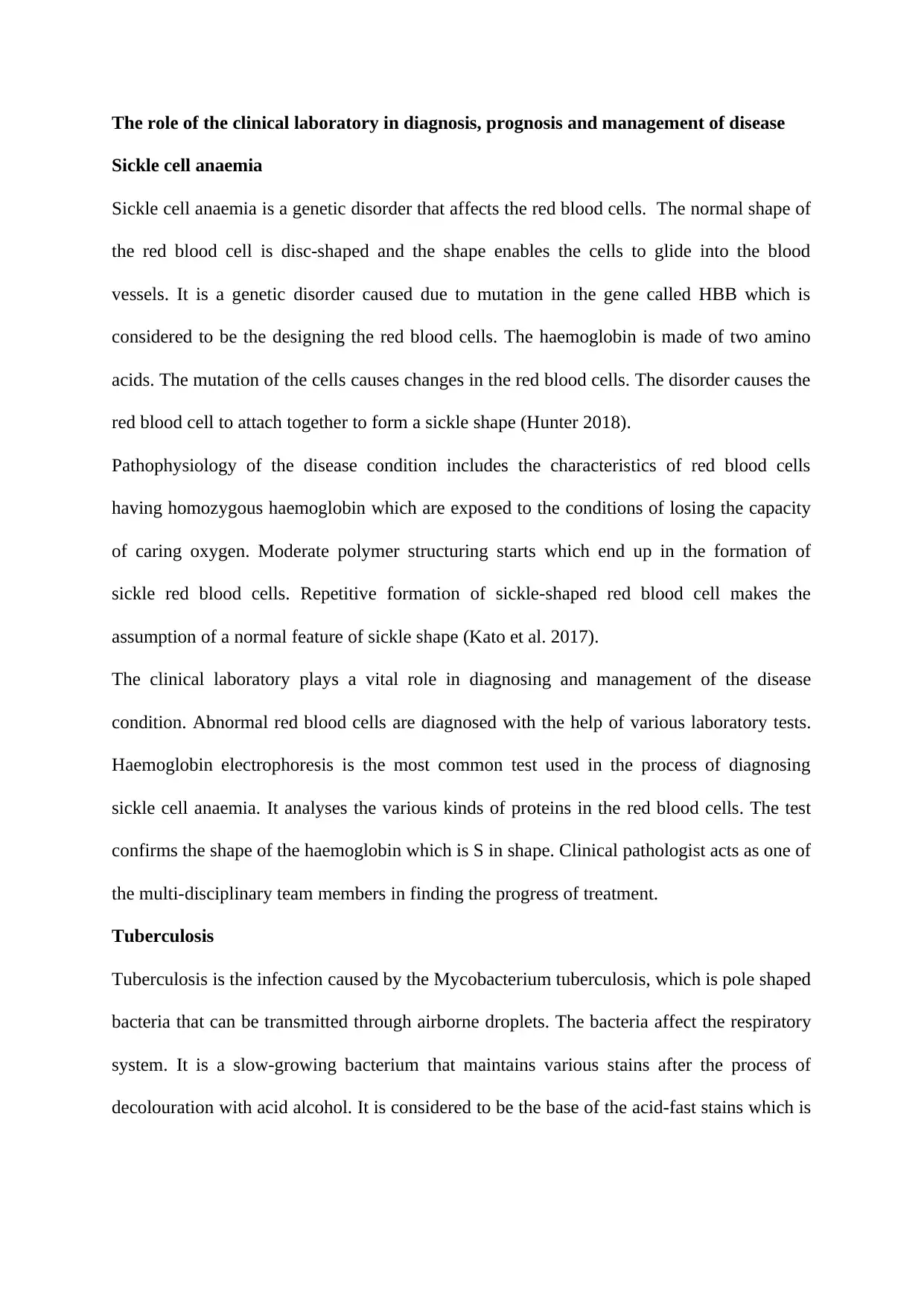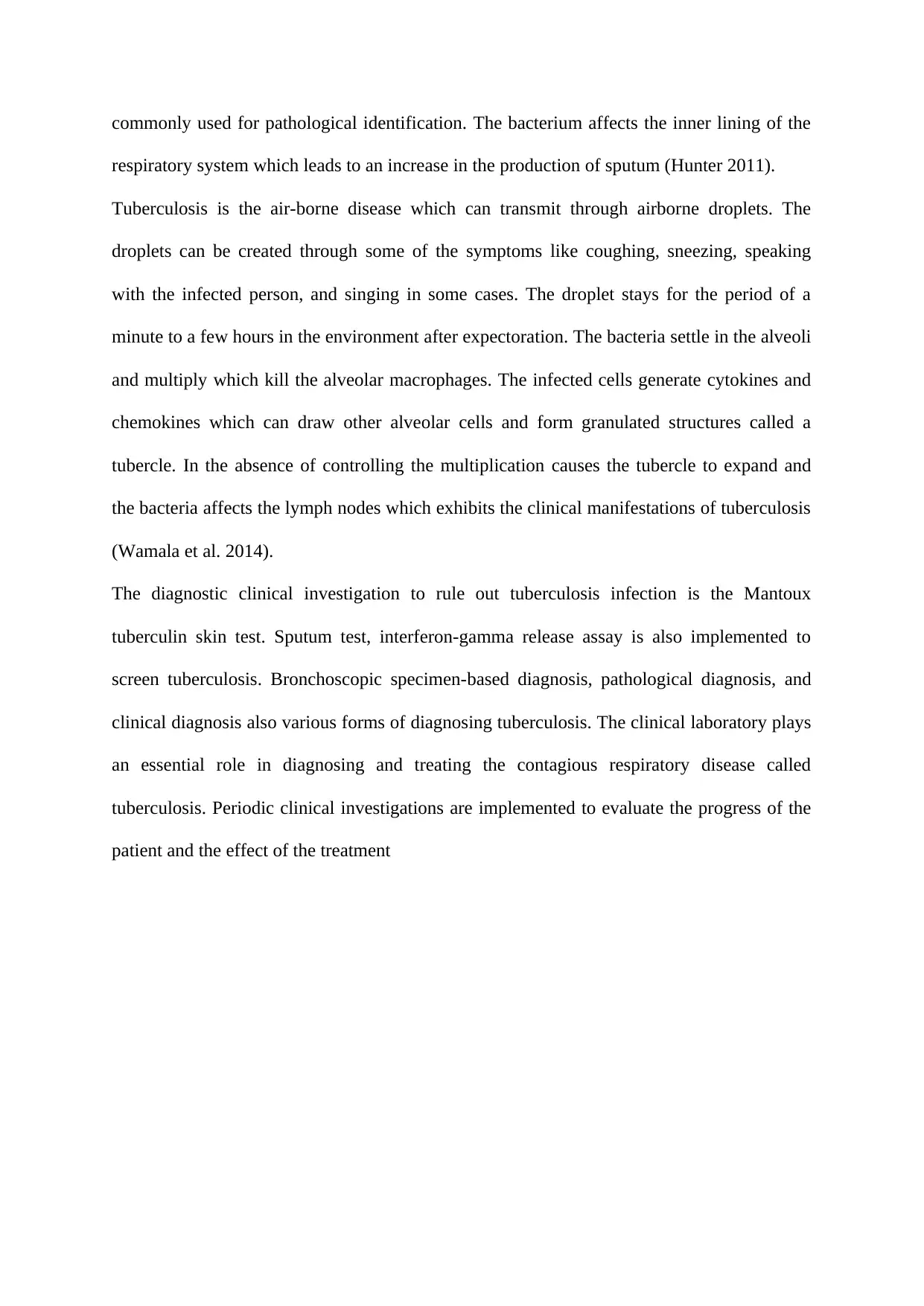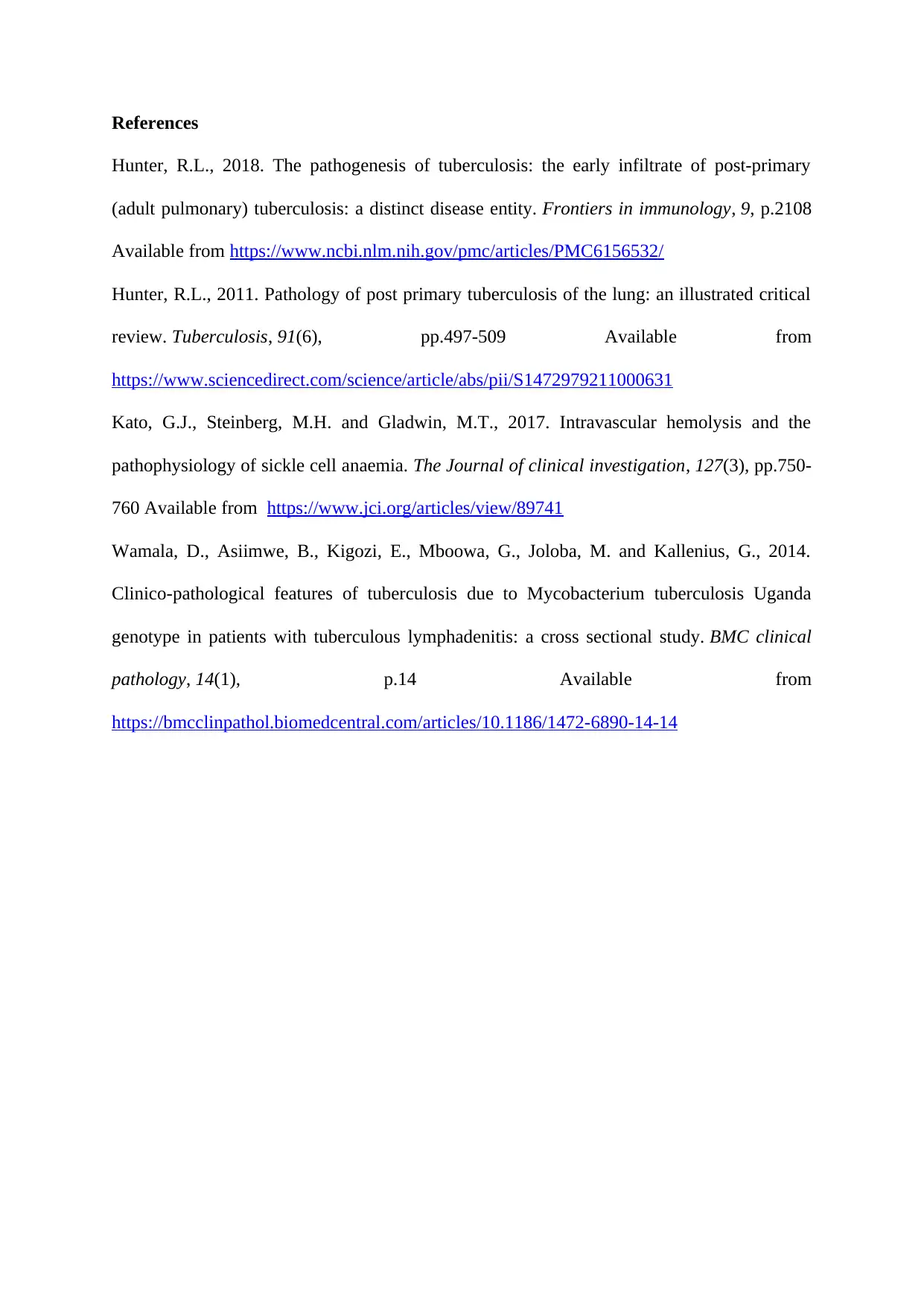The Role of Clinical Laboratory in Diagnosing and Managing Diseases
VerifiedAdded on 2022/08/13
|3
|762
|12
Report
AI Summary
This report explores the crucial role of the clinical laboratory in the diagnosis, prognosis, and management of diseases, with a specific focus on sickle cell anemia and tuberculosis. It details the pathophysiology of sickle cell anemia, a genetic disorder affecting red blood cells, and highlights the importance of hemoglobin electrophoresis in diagnosis. The report also discusses tuberculosis, an airborne infectious disease, and emphasizes the significance of tests like the Mantoux tuberculin skin test and sputum tests in its diagnosis and management. The clinical laboratory's role is highlighted as essential in both diagnosing and monitoring treatment progress for these conditions, providing a comprehensive overview of the clinical investigations involved. The report references key scientific articles to support its findings.

The role of the clinical laboratory in diagnosis, prognosis and management of disease
Sickle cell anaemia
Sickle cell anaemia is a genetic disorder that affects the red blood cells. The normal shape of
the red blood cell is disc-shaped and the shape enables the cells to glide into the blood
vessels. It is a genetic disorder caused due to mutation in the gene called HBB which is
considered to be the designing the red blood cells. The haemoglobin is made of two amino
acids. The mutation of the cells causes changes in the red blood cells. The disorder causes the
red blood cell to attach together to form a sickle shape (Hunter 2018).
Pathophysiology of the disease condition includes the characteristics of red blood cells
having homozygous haemoglobin which are exposed to the conditions of losing the capacity
of caring oxygen. Moderate polymer structuring starts which end up in the formation of
sickle red blood cells. Repetitive formation of sickle-shaped red blood cell makes the
assumption of a normal feature of sickle shape (Kato et al. 2017).
The clinical laboratory plays a vital role in diagnosing and management of the disease
condition. Abnormal red blood cells are diagnosed with the help of various laboratory tests.
Haemoglobin electrophoresis is the most common test used in the process of diagnosing
sickle cell anaemia. It analyses the various kinds of proteins in the red blood cells. The test
confirms the shape of the haemoglobin which is S in shape. Clinical pathologist acts as one of
the multi-disciplinary team members in finding the progress of treatment.
Tuberculosis
Tuberculosis is the infection caused by the Mycobacterium tuberculosis, which is pole shaped
bacteria that can be transmitted through airborne droplets. The bacteria affect the respiratory
system. It is a slow-growing bacterium that maintains various stains after the process of
decolouration with acid alcohol. It is considered to be the base of the acid-fast stains which is
Sickle cell anaemia
Sickle cell anaemia is a genetic disorder that affects the red blood cells. The normal shape of
the red blood cell is disc-shaped and the shape enables the cells to glide into the blood
vessels. It is a genetic disorder caused due to mutation in the gene called HBB which is
considered to be the designing the red blood cells. The haemoglobin is made of two amino
acids. The mutation of the cells causes changes in the red blood cells. The disorder causes the
red blood cell to attach together to form a sickle shape (Hunter 2018).
Pathophysiology of the disease condition includes the characteristics of red blood cells
having homozygous haemoglobin which are exposed to the conditions of losing the capacity
of caring oxygen. Moderate polymer structuring starts which end up in the formation of
sickle red blood cells. Repetitive formation of sickle-shaped red blood cell makes the
assumption of a normal feature of sickle shape (Kato et al. 2017).
The clinical laboratory plays a vital role in diagnosing and management of the disease
condition. Abnormal red blood cells are diagnosed with the help of various laboratory tests.
Haemoglobin electrophoresis is the most common test used in the process of diagnosing
sickle cell anaemia. It analyses the various kinds of proteins in the red blood cells. The test
confirms the shape of the haemoglobin which is S in shape. Clinical pathologist acts as one of
the multi-disciplinary team members in finding the progress of treatment.
Tuberculosis
Tuberculosis is the infection caused by the Mycobacterium tuberculosis, which is pole shaped
bacteria that can be transmitted through airborne droplets. The bacteria affect the respiratory
system. It is a slow-growing bacterium that maintains various stains after the process of
decolouration with acid alcohol. It is considered to be the base of the acid-fast stains which is
Paraphrase This Document
Need a fresh take? Get an instant paraphrase of this document with our AI Paraphraser

commonly used for pathological identification. The bacterium affects the inner lining of the
respiratory system which leads to an increase in the production of sputum (Hunter 2011).
Tuberculosis is the air-borne disease which can transmit through airborne droplets. The
droplets can be created through some of the symptoms like coughing, sneezing, speaking
with the infected person, and singing in some cases. The droplet stays for the period of a
minute to a few hours in the environment after expectoration. The bacteria settle in the alveoli
and multiply which kill the alveolar macrophages. The infected cells generate cytokines and
chemokines which can draw other alveolar cells and form granulated structures called a
tubercle. In the absence of controlling the multiplication causes the tubercle to expand and
the bacteria affects the lymph nodes which exhibits the clinical manifestations of tuberculosis
(Wamala et al. 2014).
The diagnostic clinical investigation to rule out tuberculosis infection is the Mantoux
tuberculin skin test. Sputum test, interferon-gamma release assay is also implemented to
screen tuberculosis. Bronchoscopic specimen-based diagnosis, pathological diagnosis, and
clinical diagnosis also various forms of diagnosing tuberculosis. The clinical laboratory plays
an essential role in diagnosing and treating the contagious respiratory disease called
tuberculosis. Periodic clinical investigations are implemented to evaluate the progress of the
patient and the effect of the treatment
respiratory system which leads to an increase in the production of sputum (Hunter 2011).
Tuberculosis is the air-borne disease which can transmit through airborne droplets. The
droplets can be created through some of the symptoms like coughing, sneezing, speaking
with the infected person, and singing in some cases. The droplet stays for the period of a
minute to a few hours in the environment after expectoration. The bacteria settle in the alveoli
and multiply which kill the alveolar macrophages. The infected cells generate cytokines and
chemokines which can draw other alveolar cells and form granulated structures called a
tubercle. In the absence of controlling the multiplication causes the tubercle to expand and
the bacteria affects the lymph nodes which exhibits the clinical manifestations of tuberculosis
(Wamala et al. 2014).
The diagnostic clinical investigation to rule out tuberculosis infection is the Mantoux
tuberculin skin test. Sputum test, interferon-gamma release assay is also implemented to
screen tuberculosis. Bronchoscopic specimen-based diagnosis, pathological diagnosis, and
clinical diagnosis also various forms of diagnosing tuberculosis. The clinical laboratory plays
an essential role in diagnosing and treating the contagious respiratory disease called
tuberculosis. Periodic clinical investigations are implemented to evaluate the progress of the
patient and the effect of the treatment

References
Hunter, R.L., 2018. The pathogenesis of tuberculosis: the early infiltrate of post-primary
(adult pulmonary) tuberculosis: a distinct disease entity. Frontiers in immunology, 9, p.2108
Available from https://www.ncbi.nlm.nih.gov/pmc/articles/PMC6156532/
Hunter, R.L., 2011. Pathology of post primary tuberculosis of the lung: an illustrated critical
review. Tuberculosis, 91(6), pp.497-509 Available from
https://www.sciencedirect.com/science/article/abs/pii/S1472979211000631
Kato, G.J., Steinberg, M.H. and Gladwin, M.T., 2017. Intravascular hemolysis and the
pathophysiology of sickle cell anaemia. The Journal of clinical investigation, 127(3), pp.750-
760 Available from https://www.jci.org/articles/view/89741
Wamala, D., Asiimwe, B., Kigozi, E., Mboowa, G., Joloba, M. and Kallenius, G., 2014.
Clinico-pathological features of tuberculosis due to Mycobacterium tuberculosis Uganda
genotype in patients with tuberculous lymphadenitis: a cross sectional study. BMC clinical
pathology, 14(1), p.14 Available from
https://bmcclinpathol.biomedcentral.com/articles/10.1186/1472-6890-14-14
Hunter, R.L., 2018. The pathogenesis of tuberculosis: the early infiltrate of post-primary
(adult pulmonary) tuberculosis: a distinct disease entity. Frontiers in immunology, 9, p.2108
Available from https://www.ncbi.nlm.nih.gov/pmc/articles/PMC6156532/
Hunter, R.L., 2011. Pathology of post primary tuberculosis of the lung: an illustrated critical
review. Tuberculosis, 91(6), pp.497-509 Available from
https://www.sciencedirect.com/science/article/abs/pii/S1472979211000631
Kato, G.J., Steinberg, M.H. and Gladwin, M.T., 2017. Intravascular hemolysis and the
pathophysiology of sickle cell anaemia. The Journal of clinical investigation, 127(3), pp.750-
760 Available from https://www.jci.org/articles/view/89741
Wamala, D., Asiimwe, B., Kigozi, E., Mboowa, G., Joloba, M. and Kallenius, G., 2014.
Clinico-pathological features of tuberculosis due to Mycobacterium tuberculosis Uganda
genotype in patients with tuberculous lymphadenitis: a cross sectional study. BMC clinical
pathology, 14(1), p.14 Available from
https://bmcclinpathol.biomedcentral.com/articles/10.1186/1472-6890-14-14
⊘ This is a preview!⊘
Do you want full access?
Subscribe today to unlock all pages.

Trusted by 1+ million students worldwide
1 out of 3
Related Documents
Your All-in-One AI-Powered Toolkit for Academic Success.
+13062052269
info@desklib.com
Available 24*7 on WhatsApp / Email
![[object Object]](/_next/static/media/star-bottom.7253800d.svg)
Unlock your academic potential
Copyright © 2020–2025 A2Z Services. All Rights Reserved. Developed and managed by ZUCOL.





